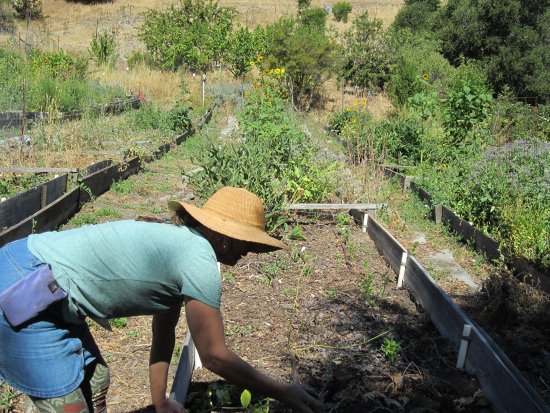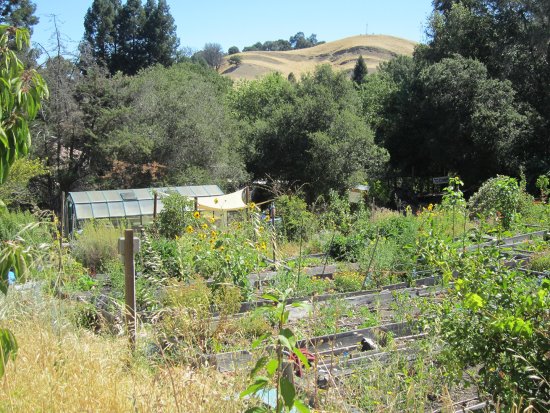
| ||||||
The Legacy Garden has continued through the years as a student-run endeavor that focuses on providing sustainable, pesticide-free produce to the dining hall and even to the on-campus catering facility. "We bring what food this produces down to the campus kitchens after those that work it have had their fill," explained Kelli Barram, Legacy Garden Manager/Educator. "Fruit, since it comes in during the summer goes down to the main cafeteria." Barram estimates that the garden feeds approximately 5,000 SMC personnel during the school year.
Barram partners with campus professors to augment the students' learning experience with an outdoor classroom. "Besides teaching sustainable ways to grow food, I also introduce health, wellness and academic enrichment," she stated. "I like to start all of my sessions with breathing and sensory exercises to help the kids settle their nervous systems." Cell phones are not allowed in the garden, and without that distraction, students come to realize how relaxing gardening can be.
Part of Barram's instruction is to steer students toward the Slow Food Movement (an Italian concept founded in 1986, that promotes local food and traditional cooking) as opposed to fast food dining. "I'm nature's interpreter," she said. "I need to help the students get `the message' in 13 weeks by participating in the growing management from seeds to actual produce."
The Legacy Garden also serves as a model for recycling by utilizing the athletic department's decades-old wooden bleachers as troughs for growing produce. Leaves and cuttings from around campus help the composting process (with the aid of worms).
Like any backyard garden, the students have to share the space with mice, voles, rats, lizards and gophers. Barram acknowledged, "We're basically participating with nature here."
A slow drip irrigation system is set on a timer to conserve water and keep the plantings wet during the hot dry months. At the moment, much of the fruit is beginning to ripen. The offerings include Gala apples, Alpine strawberries, quince, crab apples, tomatoes, tangelos, pluots, apricots, and plums. The garden also yields peppers, eggplant, squash, grapes, Swiss chard, rhubarb, and cucumbers.
Herbs such as mint, dandelion, comfrey and chamomile are also grown, and Barram teaches the students how to use them for tea and medicinal purposes.
No garden would be complete without flowers, and Legacy Garden grows sunflowers, bachelor buttons, calendula and marigolds.
There's a greenhouse on the premises where all of the plants are started to avoid being eaten by rodents and other creatures. Recently a Northern turkey crept onsite and made a nest in one of the large comfrey bushes. After laying 15 eggs, mother and poults went on their merry way.
Occasionally students will get creative ideas while working the garden. A fallen oak tree that used to provide shade in a back corner was repurposed into a table, chairs and benches to establish a communal resting space. Even an outdoor oven was built to bake pizzas for lunch.
Barram's one wish is that the garden could be more accessible to the disabled, but given the sloping hillside and precarious pathways, negotiating the terrain proves too difficult.
"Sometimes students say, `This is hard work' or they don't like the heat," recalls Barram, "but most enjoy it and are amazed at what happens in nature."

Reach the reporter at:
